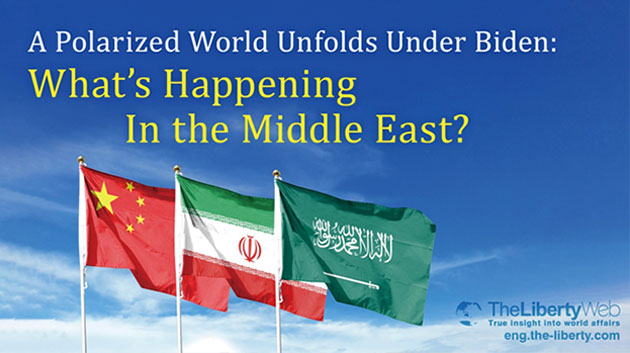A Polarized World Unfolds Under Biden : What’s Happening In the Middle East?
The Liberty explored movements in the Middle East that are at the front line of today’s Cold War structure.
As the world becomes divided in the wake of the Russia-Ukraine war, there is one region where the Cold War structure is intensifying: the Middle East.
This was demonstrated in a symbolic incident in March when Iran and Saudi Arabia restored diplomatic relations, with China acting as an intermediary. All eyes were on this historic agreement, because there has been a history of tension between these two Middle Eastern countries.
After the Iranian Revolution of 1979, Iran transformed itself from a secular state into a Shia Islamic Republic, undergoing a complete change of regime from its days as a monarchy. Saudi Arabia, with its secular monarchy, gradually began to distance itself from Iran.
With Iran taking a clear anti-U.S. stance and using the slogan “Death to America,” it was difficult for the Saudis to sympathize with Iran.
Further, in 2016, when Saudi authorities beheaded the Shia cleric Sheikh Nimr al-Nimr, a crowd of people attacked Saudi Arabia’s embassy in Tehran, the capital of Iran. This led Saudi Arabia to cut off diplomatic relations with Iran.
Why did Iran and Saudi Arabia Make Peace?
Despite all of this, the two countries have now restored diplomatic relations. This was largely due to Iran’s strained financial circumstances.
Iran suffered from economic sanctions after former U.S. President Trump withdrew from the Iran nuclear deal. The deal, agreed to by the Obama administration in 2015, offered sanctions relief to Iran in exchange for it agreeing to curb its nuclear program. After the U.S. withdrew from the deal in 2018 and put in place severe economic sanctions, prices soared and protests broke out across Iran. Further, in September 2022, a Kurdish woman from Iran died in police custody for the “crime” of improperly wearing a hijab, and a large-scale demonstration broke out. Although the protest was suppressed by Iranian authorities, the Raisi regime in Iran was in danger of not surviving unless it could break free from its siege economy. Iran had been cornered and it desperately needed help from its friends.
In addition, Iran became close to Russia by selling it drones and ammunition. It’s also been deemed likely that Russia will provide Iran with advanced systems in return, including an advanced air defense system to protect its nuclear facilities.
Meanwhile, Saudi Arabia, a country that prides itself on being a leader in the Middle East, having set forth the growth strategy “Saudi Vision 2030,” has been annoyed by the behavior of the Biden administration in recent years.
Even before Biden assumed the presidency, he criticized the Khashoggi affair, an incident in October 2018 in which Saudi Washington Post journalist Jamal Khashoggi was murdered at the Saudi consulate in Istanbul, Turkey. The Biden administration’s diplomatic policy of dividing states between democratic states and authoritarian states meant Saudia Arabia was placed in the “non-democratic” category and downgraded as a whole. This created an opportunity for Saudi Arabia to sway toward siding with the East. The Biden admininstration’s approach is in sharp contrast to the Trump administration, which, from the standpoint of realism, showed respect for Saudi Arabia, strengthened the U.S.-Saudi alliance, and kept the Saudis siding with the West.
Gradually, the Saudis began to seriously envision a post-American era. Last November, prior to the U.S. midterm elections, Saudi Arabia pushed back on Biden’s request to increase oil production, showing that they are no longer afraid to defy the U.S.
Saudi Arabia has also begun to strengthen its ties with Russia, along with China, Iran and other oil-producing countries that aren’t members of the Organization of Petroleum Exporting Countries (OPEC).
Further, China is increasing its presence in the Middle East as U.S. influence is declining in the region.
China’s reach has extended so far that it is now acting as a “peace ambassador” with enough influence over both Iran and Saudi Arabia to help them restore diplomatic relations. However, a country that suppresses human rights so heavily within its own borders cannot possibly be interested in ensuring peace. The diplomatic handshake between China and the Middle Eastern players reflects China’s ambition to eventually bring the Middle East under its control through its Belt and Road Initiative. The country is also posing yet another historic challenge to the U.S. in the region.
Biden’s Error Leads to Nuclear Arms Race in the Middle East
It didn’t have to be this way.
On September 15, 2020, Israel, the United Arab Emirates (UAE) and the Kingdom of Bahrain all normalized diplomatic relations with the help of President Trump. It was called Abraham Accords.
The peace agreements received bipartisan praise and paved the way for political and national security cooperation between Israel and the Arab states, forming a regional alliance to curb regional conflicts and deter states like Iran.
The UAE and other Arab nations realized that Israel, with its strong economic and military power, could become a potential ally.
The Abraham Accords were also essential for the Trump administration, which wanted to shift its focus from the Middle East to Asia. Without the establishment of a U.S.-led regional coalition, it would be difficult to stop Iran’s nuclear armament or China’s hegemonic expansion.
However, Biden’s poor moves have pushed Saudi Arabia away from the U.S., and growing tensions between the U.S. and Israel have become apparent as Democrats have strengthened their criticism of Israel. China simply stepped in to fill the void left by the U.S. withdrawal from the Middle East.
Although Saudi Arabia has restored diplomatic relations with Iran, it must not be forgotten that Iran has ambitions for nuclear development. Saudi Arabia, which prides itself on being the unipolar power in the Middle East, will not turn a blind eye to this. They claim they will only develop nuclear weapons if Iran acquires them, but nonetheless, Saudi Arabia has been ready to acquire nuclear weapons for some time.
Moreover, the Saudis, fed up with the U.S. ban on uranium enrichment from the standpoint of nuclear nonproliferation, have begun to seek cooperation from China in the area of nuclear development as well.
Meanwhile, Iran, which has been forming closer ties with China, Russia and Saudi Arabia, has been able to escape the dilemma caused by economic sanctions, and its regime has been able to survive longer. There is no longer any need to rush back to the nuclear deal. In addition, it has become virtually impossible for Biden to return to the nuclear deal and lift economic sanctions after Iranian authorities carried out a forceful crackdown on protesters last September. A return to the nuclear deal would only invite criticism from American citizens and the rest of the world. The Biden administration is running out of options to deter Iran from developing nuclear weapons.
An expert on Middle East affairs and the situation in Iran said that if Iran continues to enrich uranium, a nuclear war between Iran and Israel could happen in the near future. Japan, being dependent on the Middle East for 90% of its crude oil, cannot remain a bystander if war breaks out in the Middle East. Peace in the Middle East is in Japan’s national interest.
Currently, Iranian citizens are most negatively affected by American policy in the Middle East.
The irony here is that the Biden administration, which came to power largely because of its emphasis on the protection of human rights during the presidential campaign, has prolonged the life of the Raisi administration and is in fact complicit in the oppression of the Iranian people.



















